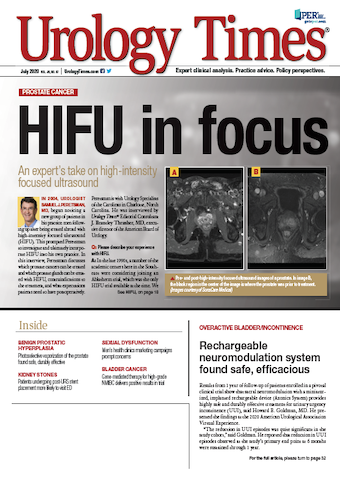Publication
Article
Urology Times Journal
Relugolix emerges as "exciting" new treatment in prostate cancer
Author(s):
Dr. Badar M. Mian highlights the safety and efficacy of relugolix, describing the drug as an “exciting new option” for patients with recurrent or advanced prostate cancer.
Badar M. Mian, MD

Injectable luteinizing hormone-releasing hormone (LHRH) agonists have been the mainstay of androgen deprivation therapy (ADT) for nearly 3 decades. The slow pace of innovation in this class of drugs has been limited mostly to the development of sustained-release injections or implants to reduce serum testosterone levels from 3 to 12 months. One exception was the approval of an injectable gonadotropin-releasing hormone (GnRH) antagonist roughly 10 years ago. Now we have the results of a phase 3 randomized trial demonstrating the efficacy and safety of relugolix, an oral GnRH antagonist, used for ADT.
The HERO trial (NCT03085095) was an international, multicenter study conducted at 155 centers comparing relugolix (120 mg orally, once daily) to leuprolide (22.5 mg injection, every 3 months) for 48 weeks. Men in need of ADT to treat prostate cancer for at least 1 year were included in the study. The indications for ADT included either biochemical (prostate-specific antigen) or clinical recurrence after primary treatment, or newly diagnosed, hormone-sensitive metastatic disease, or advanced localized disease regardless of primary treatment. Men with recent (within 6 months) cardiovascular events were excluded due to the known cardiac adverse outcomes in this cohort.
The primary end point of the study was the sustained suppression of testosterone to castrate levels, defined as testosterone less than 50 ng/dL for up to 48 weeks. Secondary end points included early suppression of testosterone at days 4, 15, and 28, and the rate of achieving very low testosterone levels of less than 20 ng/dL while on treatment. From April 2017 to October 2018, 934 patients underwent randomization in 2:1 fashion. 622 patients were assigned to receive relugolix and 308 were assigned to the leuprolide group. Treatment adherence was 99% in both groups, and 90.2% and 89.0% of the patients completed 48 weeks of treatment in the relugolix and leuprolide groups, respectively.
Sustained testosterone suppression to castrate levels through 48 weeks was achieved in 96.7% of men on relugolix and in 88.8% of men on leuprolide. The results met the predefined criteria for both noninferiority and superiority of testosterone suppression with relugolix over leuprolide (P <.001). Further, rapid testosterone suppression to less than50 ng/dL at day 4 (56% vs 0%; P <.001) and day 15 (98.7% vs 12%; P <.001) was significantly more likely with relugolix than with leuprolide. Similarly, profound suppression of testosterone to less than 20 ng/dL was seen with relugolix (78.4% vs 1%; P <.001).
In a subgroup analysis, at 90 days after discontinuation of treatment, the mean testosterone level was significantly higher in the relugolix group compared with the leuprolide (288.4 ng/dL vs 58.6 ng/dL). Fifty-four percent of men who received relugolix recovered testosterone levels compared with only 3% of men who received leuprolide (P < .001).
Lower rate of major adverse CV events with relugolix group
Of note, after 48 weeks of treatment, the incidence of major adverse cardiovascular events was 54% lower in the relugolix group than in the leuprolide group (2.9% vs 6.2%). More significantly, in men with a known medical history of cardiovascular events, the risk of major cardiovascular events during treatment was 4.8 times higher with leuprolide (17.8%) than with relugolix (3.6%). Diarrhea (grade 1-2) was more common in the relugolix group than in the leuprolide (12.2% vs 6.8%).
This study provides clear evidence of the superiority of the oral GnRH antagonist relugolix over the LHRH agonist leuprolide in providing rapid, safe and sustained suppression of testosterone in men requiring ADT. Although the authors, and others, have pointed out the avoidance of testosterone surge with relugolix, it is not clear whether that surge or “flare” noted with LHRH agonists is clinically relevant in the contemporary patient with prostate cancer. More important is the higher rate and early recovery of testosterone at the end of therapy in men treated with relugolix. This is of particular relevance in terms of quality of life, especially for men on short-term ADT or those being considered for intermittent ADT. As many as 25% of men treated with LHRH agonists for 3 years may have permanent suppression of testosterone despite the discontinuation of ADT. It remains to be determined whether long-term relugolix therapy will have similar adverse effects on testosterone recovery.
Significantly fewer major adverse cardiovascular events with relugolix is clearly important to men with prostate cancer who frequently have cardiac disease or cardiac risk factors. The advantages of GnRH antagonists over LHRH agonists (such as leuprolide) have also been observed with the injectable formulation, degarelix. The use of degarelix, despite its advantages over LHRH agonists, has not increased significantly as specialists had initially expected. Some of the cited reasons for this include the need for monthly injection, and skin reaction (typically mild) at injection site. It will be interesting to observe whether the oral GnRH antagonists are more readily embraced by the urologic community. Regardless, this study provides an exciting, new option for patients with recurrent or advanced prostate cancer, with the potential to change a long-established standard of care.
Badar M. Mian, MD, is a urology specialist at Albany Medical Center. He specializes in cancers of the prostate, kidney, and bladder, as well as the use of laparoscopic and robotic-assisted surgery to treat these diseases.
Reference
Shore ND, Saad F, Cookson MS, et al; HERO Study Investigators. Oral relugolix for androgen-deprivation therapy in advanced prostate cancer. N Engl J Med. 2020;382(23):2187-2196. doi:10.1056/NEJMoa2004325






























